I was in deepest Dingle in the southwest of Ireland and should have been bassing on the Stradbally beaches, but a gale force southeasterly wind had killed the Atlantic swell and the surf was flat.
Eating breakfast and pondering the possibilities didn’t fill me with enthusiasm. Not only had we the wind to contend with, but it was bright sunshine and a mid day high tide meant we’d only have an hour of the flood and the rest of the day on the ebb tide. Hardly ideal conditions!
Fishing buddy Norman Dunlop of the Irish Central Fisheries Board suggested we might stand a chance on the opposite side of the peninsula on a beach called Trabeg just east of Dingle. He hadn’t fished it recently but the reports were that it produced good bass, turbot, dabs and the odd ray and he reckoned it had never let him down. It would give us some weather protection too, plus had deepish water.
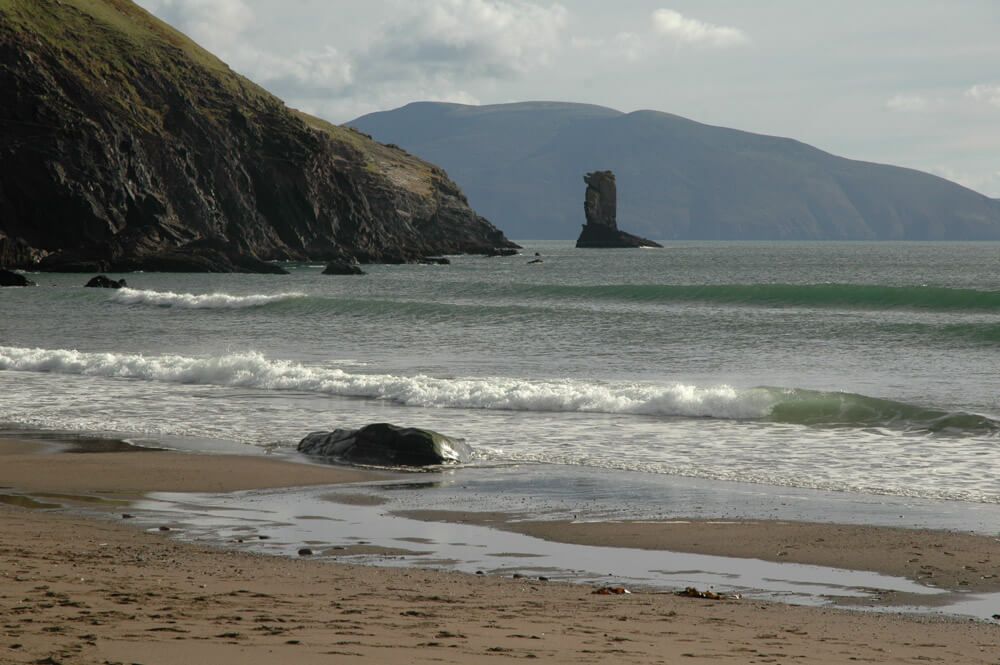
My lad, Norm, and I were to meet up with Steve Gillet, a famous name in the southeast England match scene 20-years ago and a regular on the tournament casting scene too, and now living in Kerry. He dropped my confidence even lower when he said he hadn’t heard of much coming from Trabeg over the past couple of years and that the locals didn’t rate it.
THE SESSION
Parking the car conveniently above the beach it did look fishy. A rocky headland to the east side, sand in the middle and broken rocks giving on to sand out on the right. I studied the surf pattern and realised the furthest breaker began to build about 80-yards out, with two lower surf tables working towards shore. There nothing out beyond this. This told me that there was a steep incline beyond this first wave giving in to deeper water and getting baits out to the base of this incline would be critical given the bright sunlight and surprisingly gin clear water.
I fancied fishing the west side, as from the car park vantage point it looked a little deeper. I set up both rods with racy 6500’s and thin diameter 15lb line, changing the orange leaders I use for night fishing for sand coloured leaders just to help hide everything in the gin clear seas. A one-hook clipped down rig on with just a single size 3/0 Viking hook aiming to streamline everything for maximum range was chosen for the rays, the other rod being armed with a standard three-hook flapper and size 2 Kamasan Aberdeen’s as a seeker rig just to find out what was out there.
Mike Jnr followed me and indicated he was going to drop in short for the flatties and was hoping for a turbot. Steve I’d noticed setting up just the one rod and I figured with his casting background he too would be going out to long range. Norm was tail end Charlie fishing tight up against the headland and he’d have bass and flounder in his sights.
The bait selection wasn’t as varied as I’d have liked, but we had frozen mackerel, sandeel and some manky old squid from a pier session the day before, plus a few live lugworm left over. I decided on a smallish bait, cutting a section about 2½-inches long from the tail root down to form a V shape. Passing the hook point through the skin side first I wrapped this around the hook flesh side out to maximise the leakage of the scent.
The cast was a good one and I watched the lead splash down one hell of a long way out and more importantly well beyond the lift line of the first big wave. The second seeker rig I baited with lug on the top two hooks, but added a sliver of mackerel on the bottom hook and lobbed this about 50-yards out.
It was the three-hook rig that scored first. I saw a faint triple rattle, a pause, then another rattle. It was a small plaice that scoffed the top lug bait and was really dark in colour making me think at first glance it was a dab.
While re baiting I noticed a gentle pull down on the long range rod, just enough to show on the rod tip, but the grip lead held and tension came back on the rod and stayed there. It looked like weed had hit the line and washed over it, nothing more.
Keeping my beady eye on it, a good two minutes later I saw another gentle pull. I’d been considering that given I fishing well down the incline that my line was coming over the top of this at a sharp angle and was probably buried. This would disguise all but a really savage bite and I elected to strike. I felt weight, struck and met a good solid resistance that kicked back through the rod and tried to kite away.
The fight was a typical ray, trying to sit on the seabed for a few seconds, then kiting off trying to use the tide to its advantage. I could feel the weight of the ray being dragged up the incline and was conscious of pulling a potentially light hook hold out, but the ray came over the top of the incline and immediately the resistance was much less. The ray kited off to the right again, but I got an idea just how shallow it was inside the top of the incline when I saw the ray broach on the top of wave.
My lad was with me but clicking away on the camera, so I waited for a decent bit of surf and used this to wash the ray within reach and seeing it was well hook just lifted it on the trace. It was a thornback about 5lbs, but a welcome result on the initial cast. Easing it back in to the water it didn’t hesitate and made a bolt for freedom.
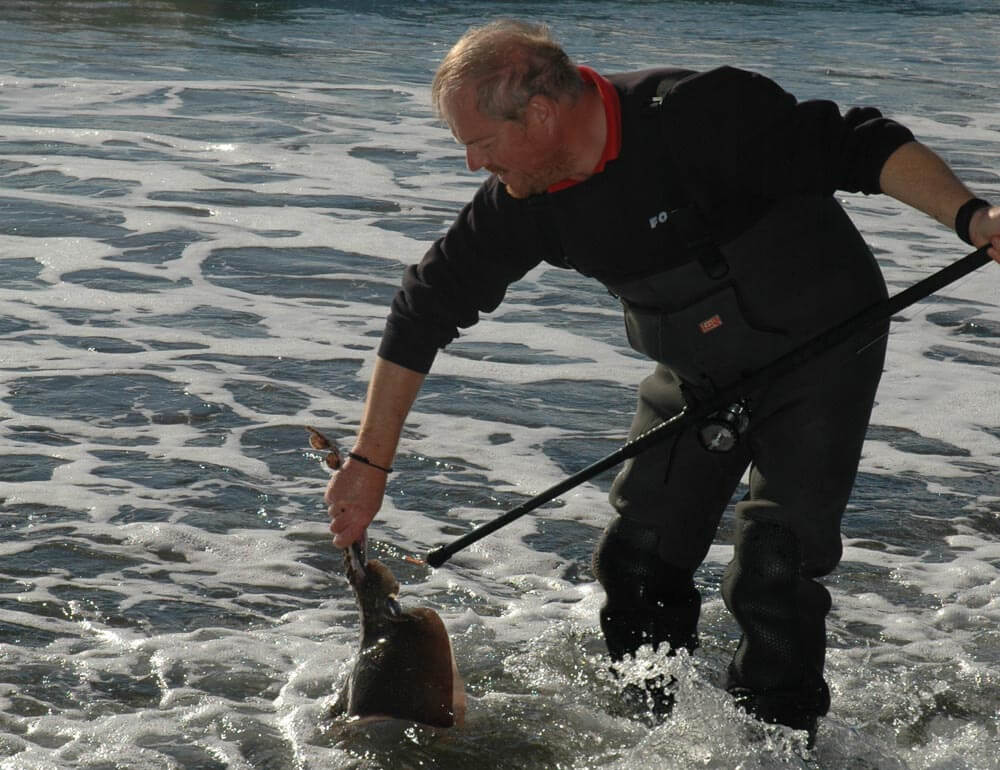
Having had a thornie, I switched over to using whole sandeel baits mounted head towards the hook point, but made sure I broke the guts of the sandeel open to release some scent before adding bait elastic for security. I was hoping to find a small-eyed ray for some variety.
Mike Jnr had had no bites yet, and mentioned he was going to lengthen his hook snoods to get the bait moving more in the surf. Within ten minutes he’d got his turbot, a cracking little fish about a pound, and as we were getting a couple of shots of it up walked Norman with a plump little flounder he’d dinked out casting just 15-yards in to the first breaker with rag tipped with mackerel.
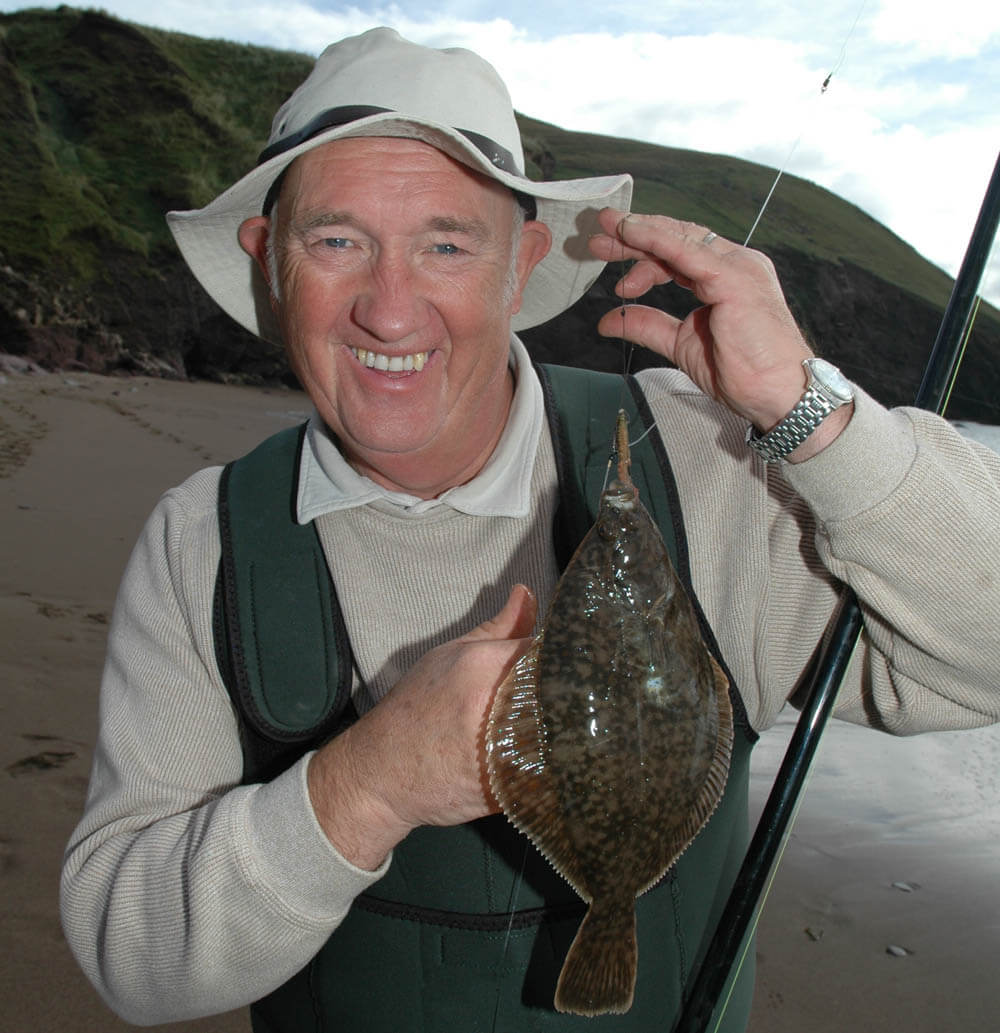
The tide was well on the ebb now, but Steve wound in another turbot and almost as quickly had another bite. I was watching sat on a rock behind my rod rest and figured he’d also got a ray on so moved across just in case he needed a hand to land the beast.
This fish was more lively and after a brief period sat on the seabed decided to scrap it out on the move working slowly up the incline trying to run from side to side. Again I saw his ray turn in the top of the wave as it breached the top of the incline and it looked like another thornback. He slid the fish up the beach and it was an identical fish to the first, beautifully mottled but with not too many thorns.
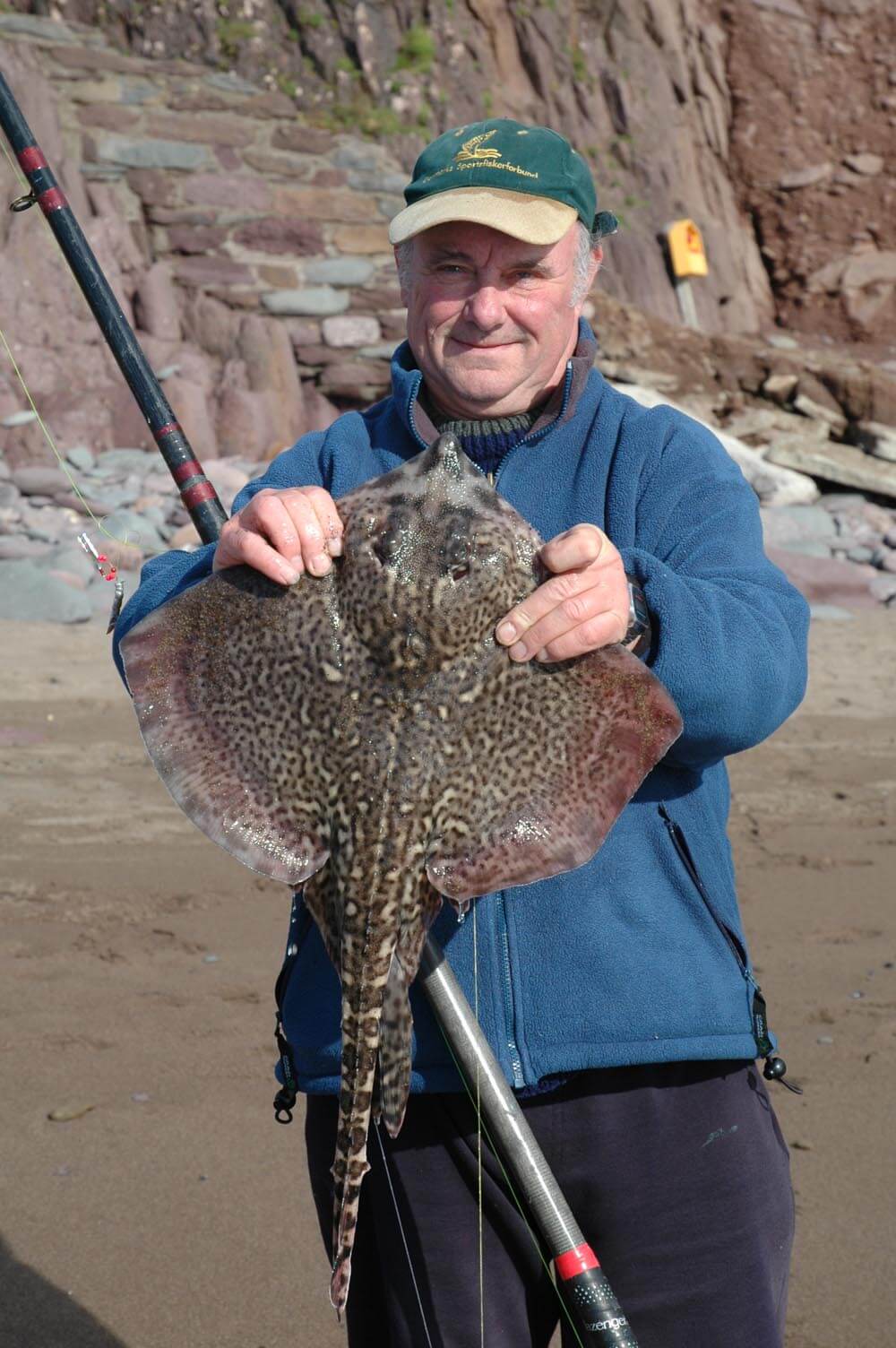
Even though the tide was a good couple of hours past the ebb now, the turbot were still feeding, both Mike Jnr and I adding another each.
I decided to change the three-hook rig and went for another ray rig baited with a mackerel/squid cocktail blasting this out to maximum range. I managed to get the lines crossed and swapped rods in the rest, in the process managing to forget which rod had which bait on.
I normally leave my baits about 15-minutes before renewing, but being lazy these had been out a good 25 minutes or more and I was just thinking about one more bait and cast when a rod tipped pulled hard down and the line sprang back slack.
I was on it in a flash, wound down until I felt weight and hit the fish hard. This one fought much harder and took a few yards of line off the reel heading back towards Dingle. It turned and hunkered down on the seabed requiring persistent pressure to get it moving again. This was how the fight went for a couple of minutes as I worked the fish up the bank.
I felt it “pop” over the top and as soon as it felt the shallow water it turned and headed back out to sea, again taking a few yards of line with it. I worked this fish gently towards shore, sure it was ray, but with the more dogged fight I was unsure what species it was.
As it finally turned at my feet I saw it was another thornback, and not that much bigger than my first, but it fought much better showing real character. That was the last fish, though if we’d stayed I reckon we could have had a couple more.
Whilst packing up I got to thinking that three rays off a surf beach in broad daylight and fast ebbing tide, plus the turbot, plaice and flounder was a decent catch given the conditions and is testimony to the quality shore fishing that still remains off the Irish west coast. I also feel the ray fishing on this beach would be spectacular in May and June, with the chance of tope too.
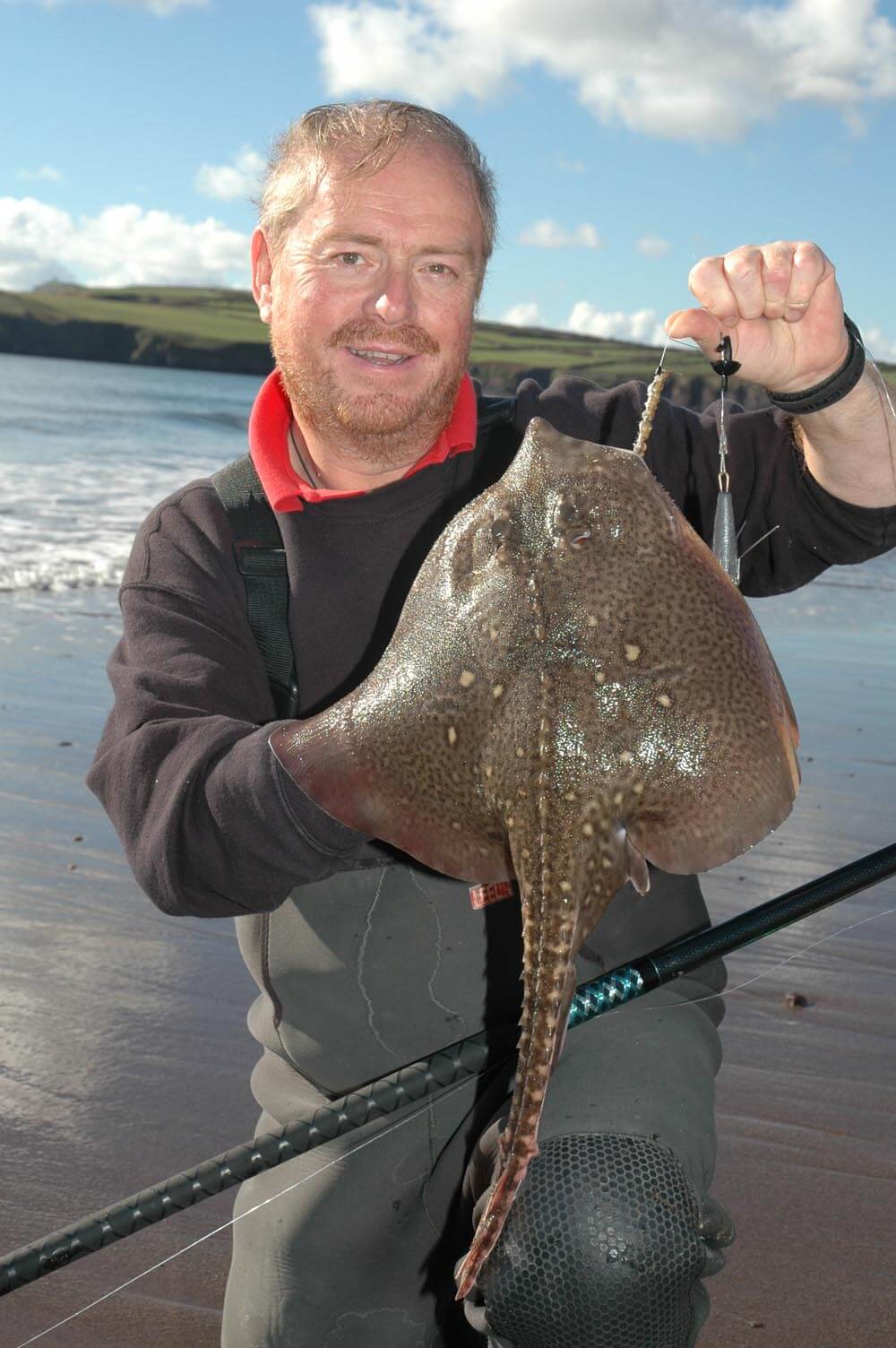
CONCLUSION
What obviously made the difference for the rays was getting the baits out to extreme range beyond the incline of the beach. That said I’m sure on a flood tide in the dark that the rays come over this incline and work much closer in to the surf line.
I also think that bigger turbot work this beach, but that these too would be much more active during a dark night flood tide.
Another lesson hammered home for the umpteenth time was that it’s all too easy to become bass blinkered when staying on the Dingle Peninsula and carry on fishing in conditions unlikely to produce much. Make this mistake and you’ll miss out on some cracking surf fishing for a variety of other species. I realised this when bumping in to some anglers in the pub at Brandon, on Fenit Pier and when coming off Trabeg Strand. Also when chatting to lads who were struggling to fish a flat calm Fermoyle Strand when we called in just to check the surf out where, as I got out of the car, nearly had my driver’s door ripped off by the wind.
It’s also well worth buying a map of the area you’re going to fish in and study it properly noting all the beaches and relating these to the wind direction at the time. If you do hit bad weather there is always somewhere here you’ll get your day in with the chance of some good fish.
Also keep a look out when travelling the main and back roads for the excellent central Fisheries Board signposts that direct you to good fishing and even list some of the likely species. Trabeg is one of these.
ACCOMMODATION
We stayed in excellent Bed & Breakfast accommodation at Castle House, Castlegregory Village, Dingle, Co Kerry. Tel: 00 353 66 7139183. E-mail: castlebnb@unison.ie and www.castlehouse-bnb.com . This is on the north side of the Dingle Peninsula and just a couple of miles away from the popular bass beaches between Stradbally and Fermoyle, but it’s just a short hop over the Conor Pass to the south side.
Crutches Hotel, Conor Pass Road, Castlegregory, Dingle Peninsula, Co Kerry. Tel: 00 353 66 713 8118 or Email: macshome@iol.ie is also very popular with visiting sea anglers and has old photos of the bassing back in the 1960’s on one of the bar walls.
Alternatively check out …www.tourismireland.com or request information from info@tourismireland.com
GENERAL INFORMATION
Castelgregory village has several pubs, a Bistro and Take Away. All the pubs are good, but Ned’s known as Natterjack’s Bar on the road westwards out of Castelgregory has lots of anglers in, as does Tomashin’s pub and restaurant on the Conor Pass road.
There is also a well stocked supermarket in Castlegregory on the bottom road just before the turn off to Fahamore.
ADMIRALTY CHARTS
Charts 2739 and 2789 cover most of the fishing area.
Eating breakfast and pondering the possibilities didn’t fill me with enthusiasm. Not only had we the wind to contend with, but it was bright sunshine and a mid day high tide meant we’d only have an hour of the flood and the rest of the day on the ebb tide. Hardly ideal conditions!
Fishing buddy Norman Dunlop of the Irish Central Fisheries Board suggested we might stand a chance on the opposite side of the peninsula on a beach called Trabeg just east of Dingle. He hadn’t fished it recently but the reports were that it produced good bass, turbot, dabs and the odd ray and he reckoned it had never let him down. It would give us some weather protection too, plus had deepish water.

My lad, Norm, and I were to meet up with Steve Gillet, a famous name in the southeast England match scene 20-years ago and a regular on the tournament casting scene too, and now living in Kerry. He dropped my confidence even lower when he said he hadn’t heard of much coming from Trabeg over the past couple of years and that the locals didn’t rate it.
THE SESSION
Parking the car conveniently above the beach it did look fishy. A rocky headland to the east side, sand in the middle and broken rocks giving on to sand out on the right. I studied the surf pattern and realised the furthest breaker began to build about 80-yards out, with two lower surf tables working towards shore. There nothing out beyond this. This told me that there was a steep incline beyond this first wave giving in to deeper water and getting baits out to the base of this incline would be critical given the bright sunlight and surprisingly gin clear water.
I fancied fishing the west side, as from the car park vantage point it looked a little deeper. I set up both rods with racy 6500’s and thin diameter 15lb line, changing the orange leaders I use for night fishing for sand coloured leaders just to help hide everything in the gin clear seas. A one-hook clipped down rig on with just a single size 3/0 Viking hook aiming to streamline everything for maximum range was chosen for the rays, the other rod being armed with a standard three-hook flapper and size 2 Kamasan Aberdeen’s as a seeker rig just to find out what was out there.
Mike Jnr followed me and indicated he was going to drop in short for the flatties and was hoping for a turbot. Steve I’d noticed setting up just the one rod and I figured with his casting background he too would be going out to long range. Norm was tail end Charlie fishing tight up against the headland and he’d have bass and flounder in his sights.
The bait selection wasn’t as varied as I’d have liked, but we had frozen mackerel, sandeel and some manky old squid from a pier session the day before, plus a few live lugworm left over. I decided on a smallish bait, cutting a section about 2½-inches long from the tail root down to form a V shape. Passing the hook point through the skin side first I wrapped this around the hook flesh side out to maximise the leakage of the scent.
The cast was a good one and I watched the lead splash down one hell of a long way out and more importantly well beyond the lift line of the first big wave. The second seeker rig I baited with lug on the top two hooks, but added a sliver of mackerel on the bottom hook and lobbed this about 50-yards out.
It was the three-hook rig that scored first. I saw a faint triple rattle, a pause, then another rattle. It was a small plaice that scoffed the top lug bait and was really dark in colour making me think at first glance it was a dab.
While re baiting I noticed a gentle pull down on the long range rod, just enough to show on the rod tip, but the grip lead held and tension came back on the rod and stayed there. It looked like weed had hit the line and washed over it, nothing more.
Keeping my beady eye on it, a good two minutes later I saw another gentle pull. I’d been considering that given I fishing well down the incline that my line was coming over the top of this at a sharp angle and was probably buried. This would disguise all but a really savage bite and I elected to strike. I felt weight, struck and met a good solid resistance that kicked back through the rod and tried to kite away.
The fight was a typical ray, trying to sit on the seabed for a few seconds, then kiting off trying to use the tide to its advantage. I could feel the weight of the ray being dragged up the incline and was conscious of pulling a potentially light hook hold out, but the ray came over the top of the incline and immediately the resistance was much less. The ray kited off to the right again, but I got an idea just how shallow it was inside the top of the incline when I saw the ray broach on the top of wave.
My lad was with me but clicking away on the camera, so I waited for a decent bit of surf and used this to wash the ray within reach and seeing it was well hook just lifted it on the trace. It was a thornback about 5lbs, but a welcome result on the initial cast. Easing it back in to the water it didn’t hesitate and made a bolt for freedom.

Having had a thornie, I switched over to using whole sandeel baits mounted head towards the hook point, but made sure I broke the guts of the sandeel open to release some scent before adding bait elastic for security. I was hoping to find a small-eyed ray for some variety.
Mike Jnr had had no bites yet, and mentioned he was going to lengthen his hook snoods to get the bait moving more in the surf. Within ten minutes he’d got his turbot, a cracking little fish about a pound, and as we were getting a couple of shots of it up walked Norman with a plump little flounder he’d dinked out casting just 15-yards in to the first breaker with rag tipped with mackerel.

The tide was well on the ebb now, but Steve wound in another turbot and almost as quickly had another bite. I was watching sat on a rock behind my rod rest and figured he’d also got a ray on so moved across just in case he needed a hand to land the beast.
This fish was more lively and after a brief period sat on the seabed decided to scrap it out on the move working slowly up the incline trying to run from side to side. Again I saw his ray turn in the top of the wave as it breached the top of the incline and it looked like another thornback. He slid the fish up the beach and it was an identical fish to the first, beautifully mottled but with not too many thorns.

Even though the tide was a good couple of hours past the ebb now, the turbot were still feeding, both Mike Jnr and I adding another each.
I decided to change the three-hook rig and went for another ray rig baited with a mackerel/squid cocktail blasting this out to maximum range. I managed to get the lines crossed and swapped rods in the rest, in the process managing to forget which rod had which bait on.
I normally leave my baits about 15-minutes before renewing, but being lazy these had been out a good 25 minutes or more and I was just thinking about one more bait and cast when a rod tipped pulled hard down and the line sprang back slack.
I was on it in a flash, wound down until I felt weight and hit the fish hard. This one fought much harder and took a few yards of line off the reel heading back towards Dingle. It turned and hunkered down on the seabed requiring persistent pressure to get it moving again. This was how the fight went for a couple of minutes as I worked the fish up the bank.
I felt it “pop” over the top and as soon as it felt the shallow water it turned and headed back out to sea, again taking a few yards of line with it. I worked this fish gently towards shore, sure it was ray, but with the more dogged fight I was unsure what species it was.
As it finally turned at my feet I saw it was another thornback, and not that much bigger than my first, but it fought much better showing real character. That was the last fish, though if we’d stayed I reckon we could have had a couple more.
Whilst packing up I got to thinking that three rays off a surf beach in broad daylight and fast ebbing tide, plus the turbot, plaice and flounder was a decent catch given the conditions and is testimony to the quality shore fishing that still remains off the Irish west coast. I also feel the ray fishing on this beach would be spectacular in May and June, with the chance of tope too.

CONCLUSION
What obviously made the difference for the rays was getting the baits out to extreme range beyond the incline of the beach. That said I’m sure on a flood tide in the dark that the rays come over this incline and work much closer in to the surf line.
I also think that bigger turbot work this beach, but that these too would be much more active during a dark night flood tide.
Another lesson hammered home for the umpteenth time was that it’s all too easy to become bass blinkered when staying on the Dingle Peninsula and carry on fishing in conditions unlikely to produce much. Make this mistake and you’ll miss out on some cracking surf fishing for a variety of other species. I realised this when bumping in to some anglers in the pub at Brandon, on Fenit Pier and when coming off Trabeg Strand. Also when chatting to lads who were struggling to fish a flat calm Fermoyle Strand when we called in just to check the surf out where, as I got out of the car, nearly had my driver’s door ripped off by the wind.
It’s also well worth buying a map of the area you’re going to fish in and study it properly noting all the beaches and relating these to the wind direction at the time. If you do hit bad weather there is always somewhere here you’ll get your day in with the chance of some good fish.
Also keep a look out when travelling the main and back roads for the excellent central Fisheries Board signposts that direct you to good fishing and even list some of the likely species. Trabeg is one of these.
ACCOMMODATION
We stayed in excellent Bed & Breakfast accommodation at Castle House, Castlegregory Village, Dingle, Co Kerry. Tel: 00 353 66 7139183. E-mail: castlebnb@unison.ie and www.castlehouse-bnb.com . This is on the north side of the Dingle Peninsula and just a couple of miles away from the popular bass beaches between Stradbally and Fermoyle, but it’s just a short hop over the Conor Pass to the south side.
Crutches Hotel, Conor Pass Road, Castlegregory, Dingle Peninsula, Co Kerry. Tel: 00 353 66 713 8118 or Email: macshome@iol.ie is also very popular with visiting sea anglers and has old photos of the bassing back in the 1960’s on one of the bar walls.
Alternatively check out …www.tourismireland.com or request information from info@tourismireland.com
GENERAL INFORMATION
Castelgregory village has several pubs, a Bistro and Take Away. All the pubs are good, but Ned’s known as Natterjack’s Bar on the road westwards out of Castelgregory has lots of anglers in, as does Tomashin’s pub and restaurant on the Conor Pass road.
There is also a well stocked supermarket in Castlegregory on the bottom road just before the turn off to Fahamore.
ADMIRALTY CHARTS
Charts 2739 and 2789 cover most of the fishing area.

